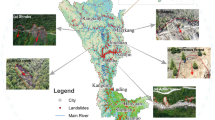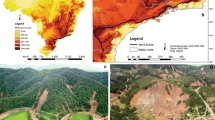Abstract
Shallow landslides are a prevalent concern in mountainous or hilly regions that can result in severe societal, economic, and environmental impacts. The challenge is further compounded as the size and location of a potential slide is often unknown. This study presents a generalized approach for the evaluation of regional shallow landslide susceptibility using an existing shallow landslide inventory, remote sensing data, and various geotechnical scenarios. The three-dimensional limit equilibrium model derived in this study uses a raster-based approach that uniquely integrates tree root reinforcement, earth pressure boundary forces, and pseudo-static seismic accelerations. Contributions of this methodology include the back-calculation of soil strength from a landslide inventory, sensitivity analyses regarding landslide size-pixel size relationships, and the determination of shallow landslide susceptibility for a landscape or infrastructure considering various root, water, and seismic conditions using lidar bare-earth DEMs as a topographic input. Using a distribution of inventoried landslide points and random points in non-landslide locales, the proposed methodology demonstrated reasonable correlation between regions of high landslide susceptibility and observed shallow landslides within a 150-km2 region of the Oregon Coast Range when the water-height ratio was 0.5. The method may be improved by considering spatial hydrologic conditions and geology more explicitly.
















Similar content being viewed by others
References
Arellano D and Stark TD (2000) “Importance of three-dimensional slope stability analyses in practice.” Geotechnical Special Publication, 18–32
Arias A (1970) Measure of earthquake intensity. Massachusetts Inst. of Tech., Cambridge. Univ. of Chile, Santiago de Chile
ASCE (2010) Minimum design loads for buildings and other structures. Standards, American Society of Civil Engineers
Ashford SA, Sitar N, Lysmer J, Deng N (1997) Topographic effects on the seismic response of steep slopes. Bull Seismol Soc Am 87(3):701–709
Ayalew L, Yamagishi H (2005) The application of GIS-based logistic regression for landslide susceptibility mapping in the Kakuda-Yahiko Mountains, Central Japan. Geomorphology 65(1):15–31
Barbosa AR, Mason HB, Romney K et al. (2014) “SSI-Bridge: soil-bridge interaction during long-duration earthquake motions.” University of Washington, Seattle, WA, USDOT University Transportation Center for Federal Region, 10
Barlow J, Barisin I, Rosser N, Petley D, Densmore A, Wright T (2015) Seismically-induced mass movements and volumetric fluxes resulting from the 2010 M w= 7.2 earthquake in the Sierra Cucapah, Mexico. Geomorphology 230:138–145
Bellugi D, Milledge DG, Dietrich WE, McKean JA, Perron JT, Sudderth EB, Kazian B (2015) A spectral clustering search algorithm for predicting shallow landslide size and location. Journal of Geophysical Research: Earth Surface 120(2):300–324
Bischetti GB, Chiaradia EA, Simonato T, Speziali B, Vitali B, Vullo P, Zocco A (2005) Root strength and root area ratio of forest species in Lombardy (Northern Italy). Plant Soil 278(1–2):11–22
Bray J, Rathje E (1998) Earthquake-induced displacements of solid-waste landfills. J Geotech Geoenviron Eng 242–253. doi: 10.1061/(ASCE)1090-0241(1998)124:3(242)
Burns WJ, Madin IP, Ma L (2008) “Statewide Landslide Information Database for Oregon (SLIDO), Release 1.” 2008 Joint Meeting of The Geological Society of America, Soil Science Society of America, American Society of Agronomy, Crop Science Society of America, Gulf Coast Association of Geological Societies with the Gulf Coast Section of SEPM
Burns WJ, Duplantis S, Mickelson KA et al. (2012) “Landslide inventory maps of the Gales Creek quadrangle, Washington County. 3rd ed.” Portland: Oregon Department of Geology and Mineral Industries
Burrough PA, McDonell RA (1998) Principles of geographical information systems. Oxford University Press, New York, p 190
Carey TJ (2014) “Multi-hazard framework and analysis of soil-bridge systems : long duration earthquake and tsunami loading.” M.S. thesis, School of Civil and Construction Engineering, Oregon State University, Corvallis, Oregon
Carrara A, Cardinali M, Detti R, Guzzetti F, Pasqui V, Reichenbach P (1991) GIS techniques and statistical models in evaluating landslide hazard. Earth Surf Process Landf 16(5):427–445
Choudhury D, Sitharam TG, Rao SK (2004) “Seismic design of earth-retaining structures and foundations.” Current science, 87(10)
Dai FC, Lee CF (2002) Landslide characteristics and slope instability modeling using GIS, Lantau Island, Hong Kong. Geomorphology 42(3):213–228
Dashti S, Bray J, Pestana J et al. (2010) Centrifuge testing to evaluate and mitigate liquefaction-induced building settlement mechanisms. J Geotech Geoenviron Eng 918–929. doi: 10.1061/(ASCE)GT.1943-5606.0000306
Dietrich WE, Reiss R, Hsu M-L, Montgomery DR (1995) A process-based model for colluvial soil depth and shallow landsliding using digital elevation data. Hydrol Process 9(3):383–400
Dietrich WE, McKean J, Bellugi D, Perron T et al. (2007a) “The prediction of shallow landslide location and size using a multidimensional landslide analysis in a digital terrain model.” Proceedings of the fourth international conference on debrisflow hazards mitigation: Mechanics, prediction, and assessment (DFHM-4). Chengdu, China 10–13
Dietrich WE, McKean J, Bellugi D et al. (2007b) The prediction of shallow landslide location and size using a multidimensional landslide analysis in a digital terrain model
Duncan JM (1996) State of the art: limit equilibrium and finite-element analysis of slopes. J Geotech Eng 122(7):577–596
Fan Y, Miguez-Macho G, Weaver CP et al. (2007) Incorporating water table dynamics in climate modeling: 1. Water table observations and equilibrium water table simulations. Journal of Geophysical Research: Atmospheres, 112(D10)
Godt JW, Baum RL, Lu N (2009) Landsliding in partially saturated materials. Geophys Res Lett 36(2)
Goldfinger C, Nelson CH, Morey AE, et al. (2012) Turbidite event history—methods and implications for Holocene paleoseismicity of the Cascadia subduction zone: U.S. Geological Survey Professional Paper 1661–F, 170 p
Gray DH and Sotir RB (1996) Biotechnical and soil bioengineering slope stabilization: a practical guide for erosion control. Wiley
Hadj-Hamou T, Kavazanjian E Jr (1985) Seismic stability of gentle infinite slopes. J Geotech Eng 111(6):681–697
Hervás J and Bobrowsky P (2009) “Mapping: inventories, susceptibility, hazard and risk.” Landslides—disaster risk reduction, K. Sassa and P. Canuti, eds., Springer Berlin Heidelberg, 321–349
Hopkinson C, Chasmer L, Barr AG, Kljun N, Black TA, McCaughey JH (2016) Monitoring boreal forest biomass and carbon storage change by integrating airborne laser scanning, biometry and eddy covariance data. Remote Sens Environ 181:82–95
Hynes-Griffin, ME, Franklin AG (1984) Rationalizing the seismic coefficient method (No. WES/MP/GL-84-13). Army Engineer Waterways Experiment Station Vicksburg Ms Geotechnical Lab
Iida T (2004) Theoretical research on the relationship between return period of rainfall and shallow landslides. Hydrol Process 18(4):739–756
Jaboyedoff M, Oppikofer T, Abellán A, Derron MH, Loye A, Metzger R & Pedrazzini A (2012) Use of LIDAR in landslide investigations: a review. Nat Hazards 61(1):5–28
Jaky J (1944) The coefficient of earth pressure at rest. Journal of the Society of Hungarian Architects and Engineers 78(22):355–358
James RG, Bransby P (1970) Experimental and theoretical investigations of a passive earth pressure problem. Geotechnique 20(1):17–37
Jibson RW, Harp EL, Michael JA (2000) A method for producing digital probabilistic seismic landslide hazard maps. Eng Geol 58(3):271–289
Kottke A, Rathje EM (2008) A semi-automated procedure for selecting and scaling recorded earthquake motions for dynamic analysis. Earthquake Spectra 24(4):911–932
Leshchinsky BA, Olsen MJ, Tanyu BF (2015) Contour connection method for automated identification and classification of landslide deposits. Comput Geosci 74:27–38
Liang T, Knappett JA & Duckett N (2015) Modelling the seismic performance of rooted slopes from individual root-soil interaction to global slope behaviour. Géotechnique 65(12):995–1009
Mahalingam R, Olsen MJ (2015) “Evaluation of the influence of source and spatial resolution of DEMs on derivative products used in landslide mapping.” Geomat Nat Haz Risk, 1–21
Mahalingam R, Olsen MJ & O’Banion MS (2016) Evaluation of landslide susceptibility mapping techniques using lidar-derived conditioning factors (Oregon case study). Geomat Nat Haz Risk 7(6):1884–1907
Melgar D, LeVeque RJ, Dreger DS, Allen RM (2016) Kinematic rupture scenarios and synthetic displacement data: an example application to the Cascadia Subduction Zone. J Geophys Res Solid Earth 121(9):6658–6674
Milledge DG, Griffiths DV, Lane SN, Warburton J (2012) Limits on the validity of infinite length assumptions for modelling shallow landslides. Earth Surf Process Landf 37(11):1158–1166
Milledge DG, Bellugi D, McKean JA, Densmore AL, Dietrich WE (2014) A multidimensional stability model for predicting shallow landslide size and shape across landscapes. Journal of Geophysical Research: Earth Surface 119(11):2481–2504
Miller DJ, Sias J (1998) Deciphering large landslides: linking hydrological, groundwater and slope stability models through GIS. Hydrol Process 12(6):923–941
Ohlmacher GC, Davis JC (2003) Using multiple logistic regression and GIS technology to predict landslide hazard in northeast Kansas, USA. Eng Geol 69(3):331–343
Parker RN, Densmore AL, Rosser NJ, De Michele M, Li Y, Huang R et al (2011) Mass wasting triggered by the 2008 Wenchuan earthquake is greater than orogenic growth. Nat Geosci 4(7):449–452
Petley D (2012) Global patterns of loss of life from landslides. Geology 40(10):927–930
Roering JJ, Schmidt KM, Stock JD, Dietrich WE, Montgomery DR (2003) Shallow landsliding, root reinforcement, and the spatial distribution of trees in the Oregon Coast Range. Can Geotech J 40(2):237–253
Rong Y, Jackson DD, Magistrale H, Goldfinger C (2014) Magnitude limits of subduction zone earthquakes. Bull Seismol Soc Am 104(5):2359–2377
Sakals ME, Sidle RC (2004) A spatial and temporal model of root cohesion in forest soils. Can J For Res 34(4):950–958
Schmidt KM, Roering JJ, Stock JD, Dietrich WE, Montgomery DR, Schaub T (2001) The variability of root cohesion as an influence on shallow landslide susceptibility in the Oregon Coast Range. Can Geotech J 38(5):995–1024
Schuster RL (1996) “Socioeconomic significance of landslides.” Landslides: investigation and mitigation. Washington (DC): National Academy Press. Transportation Research Board Special Report, 247, 12–35
Schwarz M, Lehmann P, Or D (2010) Quantifying lateral root reinforcement in steep slopes—from a bundle of roots to tree stands. Earth Surf Process Landf 35(3):354–367
Seed HB, Martin GR (1966) The seismic coefficient in earth dam design. Journal of Soil Mechanics & Foundations Div, 92(Proc. Paper 4824)
Shukla SK (2013) Generalized analytical expression for dynamic passive earth pressure from c–φ soil backfills. Int J Geotech Eng 7(4):443–446
Shukla SK (2015) Generalized analytical expression for dynamic active thrust from c–φ soil backfills. Int J Geotech Eng 9(4):416–421
Sithole G, Vosselman G (2004) Experimental comparison of filter algorithms for bare-earth extraction from airborne laser scanning point clouds. ISPRS J Photogramm Remote Sens 59(1):85–101
Tsai T-L, Yang J-C (2006) Modeling of rainfall-triggered shallow landslide. Environ Geol 50(4):525–534
Umar Z, Pradhan B, Ahmad A, Jebur MN & Tehrany M.S (2014) Earthquake induced landslide susceptibility mapping using an integrated ensemble frequency ratio and logistic regression models in West Sumatera Province, Indonesia. Catena 118:124–135
van Westen C, Terlien MJT (1996) An approach towards deterministic landslide hazard analysis in GIS. A case study from Manizales (Colombia). Earth Surf Process Landf 21(9):853–868
Youssef AM, Pradhan B, Jebur MN & El-Harbi HM (2015) Landslide susceptibility mapping using ensemble bivariate and multivariate statistical models in Fayfa area, Saudi Arabia. Environ Earth Sci 73(7):3745–3761
Waldron LJ (1977) The shear resistance of root-permeated homogeneous and stratified soil. Soil Sci Soc Am J 41(5):843–849
Wang Y, Rathje EM (2015) Probabilistic seismic landslide hazard maps including epistemic uncertainty. Eng Geol 196:313–324
Westergaard HM (1933) Water pressures on dams during earthquakes. Trans ASCE 98:418–432
Wu W, Sidle RC (1995) A distributed slope stability model for steep forested basins. Water Resour Res 31(8):2097–2110
Wu TH, McKinnell WP III, Swanston DN (1979) Strength of tree roots and landslides on Prince of Wales Island, Alaska. Can Geotech J 16(1):19–33
Xie M, Esaki T, Cai M (2006) GIS-based implementation of three-dimensional limit equilibrium approach of slope stability. J Geotech Geoenviron 132(5):656–660
Xu C, Xu X, Yao Q, Wang Y (2013) GIS-based bivariate statistical modelling for earthquake-triggered landslides susceptibility mapping related to the 2008 Wenchuan earthquake, China. Q J Eng Geol Hydrogeol 46(2):221–236
Acknowledgements
The authors appreciate the lidar data provided for this study by the Oregon Lidar Consortium and DOGAMI. They would also acknowledge partial funding for this project by the Oregon Department of Transportation (SPR 786). Additional support by the National Institute of Food and Agriculture, U.S. Department of Agriculture, McIntire Stennis project under 1002779 is acknowledged.
Author information
Authors and Affiliations
Corresponding author
Rights and permissions
About this article
Cite this article
Hess, D.M., Leshchinsky, B.A., Bunn, M. et al. A simplified three-dimensional shallow landslide susceptibility framework considering topography and seismicity. Landslides 14, 1677–1697 (2017). https://doi.org/10.1007/s10346-017-0810-2
Received:
Accepted:
Published:
Issue Date:
DOI: https://doi.org/10.1007/s10346-017-0810-2




